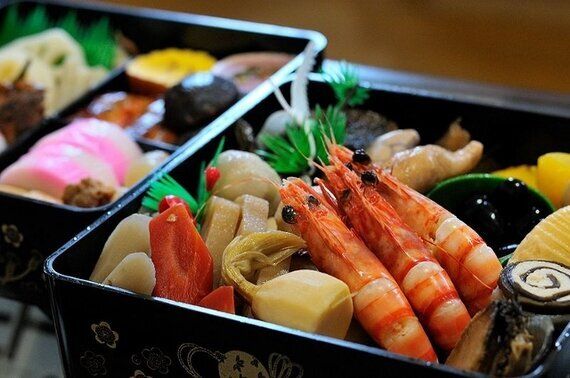
photo by Masaaki Komori under a Creative Commons License
How do Japanese celebrate holidays? New Year is the biggest holiday of the year in Japan.Since 1873 Japanese have been celebrating New Year according to the Gregorian calendar on January 1 of each year, although some parts of Japan, such as Okinawa, still celebrate it according to the Chinese calendar. Japanese New Year traditions involve decorating the house, spending time with families, eating specially prepared meals called "osechi-ryouri," going to a shrine to pray, and taking time off from work. In many ways it is similar to how Americans celebrate Christmas.
On the other hand, Christmas is a secular holiday to most Japanese. It is estimated that 1 % of Japan's population is Christian, but Japanese have adapted Christmas traditions in their own ways. On Christmas Eve young people have a party with friends and spend time with their boyfriend/girlfriend. Families share a Christmas cake and decorate a small tree in their homes while children go to bed, excited about Christmas presents from Santa Claus.
Strangely enough, Santa behaves differently in Japan: Instead of leaving presents under the trees, he puts them next to a child's bed. Given that most Japanese families don't have big Christmas trees, he has no choice. But there is one problem: Many children stay up, pretending to be asleep with their eyes closed, and waiting for Santa Claus only to learn that Santa was their mom or dad.
To simplify it I've often described that Christmas in Japan is like New Year in America and vice versa. What's harder to explain is the things Japanese do not do in New Year during "mochū, (喪中)" a mourning period. If a relative or someone close to us died in the previous year, we don't celebrate New Year. I explained this custom in the recent post of my other blog (Yumiko Sato Music Therapy) in the context of coping with grief.
During mochū, we don't eat osechi-ryouri or send nengajo, New Year's greeting cards. Instead, we send mochū hagaki (mochu postcards) to let friends and acquaintances know that we had death in our family, and that we are not able to participate in the New Year celebrations. During mochū we don't place New Year decorations inside and outside homes as we normally would. These decorations include items such as pine and bamboo, sacred straw festoons, and oval shaped rice cakes. So if you see a house with no New Year decoration, it may be beacuse there was death in the family in the previous year.
Mochū has many purposes, one of which is to take the pressure to celebrate the holiday off of the bereaved. Another is to pray for the repose of the deceased. Not all traditions and customs are good or relevant, but some remain useful. Mochū is one of those old traditions that are still suitable today, because it allows us to be sensitive to the bereaved.
Another old tradition related to New Year is the custom of cleaning the house at the end of the year, called "oosouji (extensive cleaning)." Some people implement oosouji in schools and at work as well. It's important for Japanese to welcome a new year in a clean state. My memories of New Year's Eve consist of my mother dusting and cleaning every corner of the house. I didn't like this custom as a child, since she would often ask for my help. But it's one of the few Japanese holiday traditions I've kept while living abroad most of my adult life. It's good to dust yourself off once in a while.
As for the rest of the holiday traditions, I'll have more to report in January. In the meantime, I've already began cleaning my house.
More from Discover Japan Blog:
